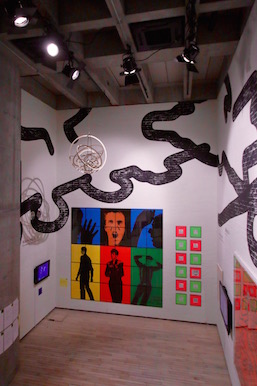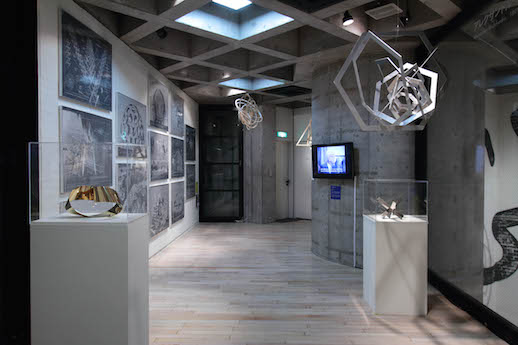Troublemakers

Chapter One on the fourth floor features works by six artists on the theme of “Resistance”. These protagonists of the counterculture movements of the 1960s include participants in the Fluxus movement, who attempted to demolish boundaries between art and life. They dismissed the elitist world of high art and kept power balances in mind while using humour to address history. In the center of the room stands Huang Yong Ping’s 49.6 meter-long Emergency Ladder (1992), an installation of Chinese iron knives that portrays human beings aiming towards the sky and overcoming obstacles. This piece was originally created for Watari-um’s 1992 exhibition “Resistance”, co-produced with French artist Jean-Hubert Martin. Yong Ping is considered one of the most controversial and provocative artists in China, and is often compared to fellow avant-gardists such as John Cage and Joseph Beuys, also featured in “Rebel Without a Cause”.
Watari-um displays John Cage’s Not Wanting to Say Anything About Marcel (1969), a tribute to Marcel Duchamp, the father of conceptual art and a friend and mentor of Cage. The work is comprised of eight plexigrams, with plexiglass panels inserted from the top onto a wooden base. There are texts and images on each of the plexigrams. The diction, size, angle, color and ideas are determined by Cage and the other artists who assisted him in crafting and silkscreening the panels. There is no main focus, you can jump from image to image, layer to layer, each time with a different experience while creating your own contexts and meanings. Joseph Beuys, who in the 1970s worked to expand and redefine the concept of sculpture and art to education, cultural revolution, and social sculpture, is represented with Dumme Kiste (1983), or “a dumb box”. This work about principles of heat, isolation and currents of warmth places pieces of cloth on the four edges of a box to intercept copper plates, thereby interrupting conductibility.
The Korean artist Nam June Paik, widely known as the pioneer of video art, was hugely inspired by John Cage, and as a member of Fluxus worked to humanize technology and express himself through audio visual and electronic elements. Similarly, Yoko Ono is recognised for her crucial role in Fluxus and was also inspired by Cage. Watari-um displays her Play It by Trust (1986-87), an all white chessboard that focuses on the idea of interaction and the potential of chance and humanity, rather than the divisions between people. The work implies it is not always possible to distinguish the enemy and that life is not about winning or losing. Nobuaki Takekawa, meanwhile, is a Japanese artist who participates in protest demonstrations and whose works are based mainly on political and social matters. He holds a critical attitude towards society, challenging the old practices of art history. His ¡No Pasarán! (2013) is an installation of spiked baseball bats.

Chapter 2 of the exhibition, “Design Revolution”, explores the relevancy and application of design through the works of Buckminster Fuller, Max Bill and Alexander Rodchenko. Architect and designer Buckminster Fuller sought to satisfying the increasing needs of the world’s population, believing that engineering and science were the answer to the paradoxes of the finite resources. His ideas are ecocentric and rooted in utilitarian philosophy. He coined the term “ephemeralization”, the idea of using “more and more with less and less until eventually you can do everything with nothing”. Max Bill, one of the “last Bauhaus masters”, is famous for his work in architecture, sculpture, design, education and politics incorporating geometry and mathematical concepts into art practices. The Russian artist Alexander Rodchenko specialised in painting, photography and design, often integrating art into everyday life to bring it to the masses. Ranging from book covers to advertisements, posters, and sculptures, Rodchenko’s works are based on politically challenging ideas, particularly those backed by Constructivism utilizing expertise in science and mathematics.
The last chapter of “Rebel Without a Cause” shares the same title as the exhibition as well as the classic 1955 Nicholas Ray film exploring topics of homosexuality and teen alienation. In this section, Watari-um exhibits the artwork of Andy Warhol, Keith Haring, Gilbert & George, Allen Ginsberg, Robert Mapplethorpe and BIEN, a Japanese artist inspired by street culture. The final chapter conveys the necessity of engaging with creativity and emotion to keep logic in balance. Through the spirit of these 15 artists, the exhibition “Rebel Without a Cause” makes the case that human creativity and innovation have the power to solve problems and blur the distinction between ordinary and artistic life. If you’re looking for best australian casinos you can find it at onlinecasinos-australia.com

MuPon and TABapp offer ¥300 admission discounts to this show.



